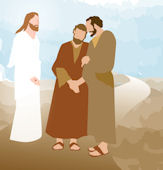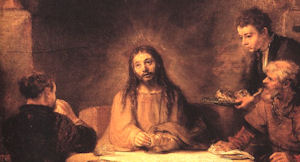In God Without Being, Jean-Luc Marion explores the Eucharistic event as the scene of inbreaking of God's unconditional gift to humanity – a theological site where sign, locutor, and referent all converge in the person of Jesus Christ, the living Word.[1] However, along with the gift Marion includes a conditional that keeps on giving: the bishop as mediator of Christ, or put another way, a human male claiming apostolic succession within a rigidly defined hierarchy who, acting in persona Christi, presides over the Eucharist as the icon of the invisible Christ.
But is this the only reading of the Eucharistic text? Using Derrida's concepts of iterability and (un)translatability, I propose to explore the development of the Eucharistic celebration as a text that has moved through countless iterations since its first appearance with Jesus and his disciples. Along the way we will discover room within the text for a woman to celebrate the Eucharist, as well as the unordained.
Of the Eucharistic Site of Theology
Marion begins his argument by asserting that the one thing that separates Christian theology from all other theological discourse is Jesus Christ. Unlike many other religions that have a prophet or teacher who claims to speak on behalf of God, Jesus instead claims to be the Word of God.[2] The Word, we are told, cannot be spoken in any human language, as it transgresses the normal rules of language, merging as an indissoluble whole the speaker, sign and referent, closing the gap between sign and referent normally found in the human condition and the distance that separates us from God.[3] Jesus serves the disciples as a living icon of the God who cannot be inscribed in human speech. Unlike humanity, which Marion suggests is constituted by our speech, the Word exists before any human language, coming to us not from our side, but from an anteriority to our language, meeting us within our construct.
The first disciples, had access to the living, breathing, incarnate Jesus in their midst. But from the time of the death and resurrection of Jesus, the Christ, this physical access has been closed. Instead, we possess the body of New Testament texts which serve as signs pointing to what Marion refers to as "the foreclosed event."[4] Whether through direct proclamation of the event, allusion, or examining its contours through a study of the entire New Testament corpus, we have only words of testimony that point to the original event. But such texts are not the event themselves. At best, they can serve only as markers indicating where the event took place. Marion compares them to the traces left on a wall that witness to the unbearable radiation of a prior nuclear explosion or as the visible signs of an invisible irruption.[5] But the traces of the event no longer open up to the event itself.
Because the Word is no longer present in the same way, Marion asserts, we are given the theologian who "proceeds to a hermeneutic of the biblical text that does not aim at the text but, through the text, at the event, the referent."[6] The Word is not inscribed within the text. "The theologian," Marion tells us, "must go beyond the text to the Word, interpreting it from the point of view of the Word."[7] The theologian does this not through his own words, but by allowing the Word to speak him.[8]
Here Marion turns to the Emmaus road event, providing relevant exegesis to illustrate his point. In Luke 24 we find the resurrected Jesus walking along the road to Emmaus with Cleopas and his unnamed companion. They relate to Jesus (whom they do not recognize) the events that took place in Jerusalem, beginning with Jesus' own crucifixion and death and culminating with the account of the empty tomb. A group of women, disciples from their company, claim to have seen a vision of angels who told them that Jesus was indeed risen. Others from their group had gone and confirmed the empty tomb, but saw no signs of Jesus or angels. At this point Jesus begins to interpret (Old Testament) scripture to his fellow travelers, explaining the necessity of his death before entering into glory. Stopping at Emmaus, the disciples invite Jesus to stay with them for the night. During dinner, Jesus takes bread, blesses it and breaks it and then, Luke tells us, their eyes are suddenly opened to see who Jesus truly is just as he disappears.
The disciples rush back to Jerusalem, reflecting on how their hearts had been kindled as Jesus had explained the scriptures to them. On arriving, they find the 11 and recount[9] their story. And as they are talking Jesus appears in their midst. Again he explains to his disciples how the words of scripture had foretold his suffering and resurrection, opening their minds that they might understand.
Marion asserts that in this incident, Jesus established the pattern of worship that would serve as the model for subsequent Eucharistic performances within the community of believers. The Word is first to be interpreted to those gathered through the exposition of scripture (the sermon), followed by the Eucharist which completes the hermeneutic, opening the scriptures to our understanding, allowing us to follow their pointing to the very referent of Christ, "the nontextual Word of the words."[10] Only in this way are we able to experience what the original disciples experienced: the Word who irrupts into our consciousness and interprets himself in our midst. "The Christian assembly that celebrates the Eucharist unceasingly reproduces this hermeneutic site of theology," Marion tells us, with the understanding that they seek not an understanding of the biblical texts used in the service, but comprehension of the Word. Marion then suggests that it is the priest presiding over the Eucharist who completes the hermeneutic, in repetition of Christ's own performance found in Luke 24:27. But by the end of his argument, the priest has become a deputy of the bishop who provides liturgical service as the theologian par excellence within the hermeneutic.[11]
At face value, Marion's exposition seems to indicate that a relatively small number of human beings are capable of fulfilling the role of mediator of Christ to the world within the Eucharistic hermeneutic. Though the bishop may delegate authority to priests, the pool of acceptable candidates remains limited. In his critique of Marion's work, John Caputo claims that Marion has entered the realm of onto-theo-political discourse, violently excluding anyone who cannot live within the structure of the Roman Catholic teaching on the bishop's primacy.[12] However, Robyn Horner offers a more charitable interpretation for Marion's words, suggesting that while the narrow view would only include the bishop and his delegates, Marion (who is not ordained) has left open the question of what it means to be in tune with the authorities of the Church, suggesting that there is a place for the lay theologian who honors the Church's position and teaching. However, even Horner must concede that as presented Marion's argument has serious implications for laity, including all women.[13] Having thus defined our problem, our next post will move to a few tools offered by Jacques Derrida that may prove useful to our project.
[1] Jean-Luc Marion, God Without Being: Hors-texte, trans. Thomas A. Carlson (Chicago: University of Chicago Press, 1991). 141.
[2] While this is Marion's claim, the Johannine text to which he is heavily indebted never explicitly puts these words in Jesus' mouth.
[3] Marion, God Without Being: 140-41. Also noting that John 10.30 reads, "I and the Father are one," reiterating Jesus unique position as speaker and referent.
[4] Ibid., 144.
[5] Ibid., 145.
[6] Ibid., 148.
[7] Ibid., 149., emphasis in original.
[8] I purposefully follow here Marion's use of masculine language as a foreshadowing of what is to come.
[9] Or, as Marion points out, "did the exegesis, exegounton." Marion, God Without Being: 151.
[10] Ibid., 150.
[11] Ibid., 152-53.
[12] John D. Capto, "How to Avoid Speaking of God: The Violence of Natural Theology," in Prospects for Natural Theology, ed. Eugene Thomas Long (Washington, D.C.: Catholic University of America Press, 1992), 145-47.
[13] Robyn Horner, Jean-Luc Marion: A Theo-logical Introduction (Aldershot, Hants, England ; Burlington, VT: Ashgate, 2005). 10-11.





